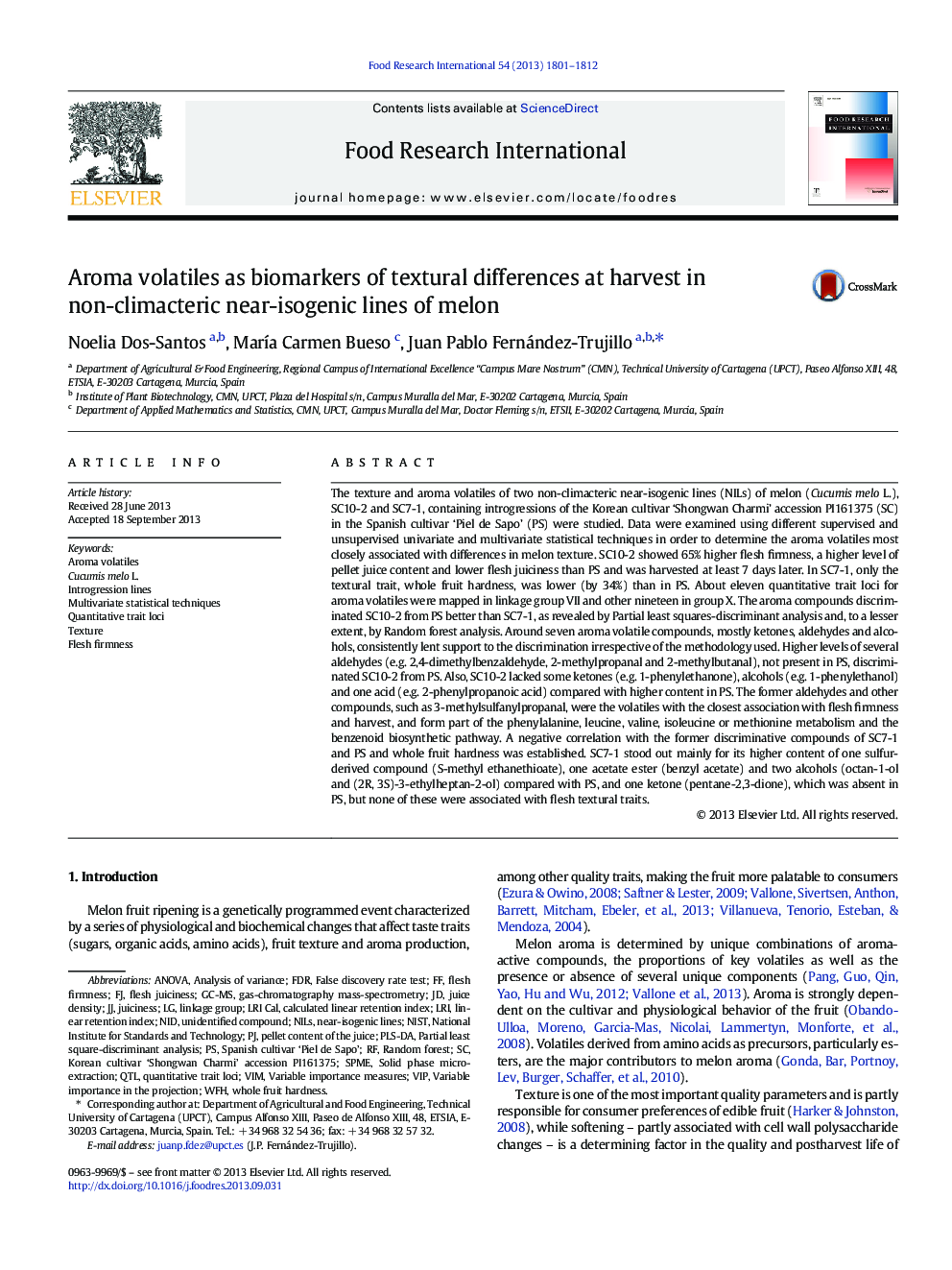| Article ID | Journal | Published Year | Pages | File Type |
|---|---|---|---|---|
| 6397441 | Food Research International | 2013 | 12 Pages |
Abstract
The texture and aroma volatiles of two non-climacteric near-isogenic lines (NILs) of melon (Cucumis melo L.), SC10-2 and SC7-1, containing introgressions of the Korean cultivar 'Shongwan Charmi' accession PI161375 (SC) in the Spanish cultivar 'Piel de Sapo' (PS) were studied. Data were examined using different supervised and unsupervised univariate and multivariate statistical techniques in order to determine the aroma volatiles most closely associated with differences in melon texture. SC10-2 showed 65% higher flesh firmness, a higher level of pellet juice content and lower flesh juiciness than PS and was harvested at least 7Â days later. In SC7-1, only the textural trait, whole fruit hardness, was lower (by 34%) than in PS. About eleven quantitative trait loci for aroma volatiles were mapped in linkage group VII and other nineteen in group X. The aroma compounds discriminated SC10-2 from PS better than SC7-1, as revealed by Partial least squares-discriminant analysis and, to a lesser extent, by Random forest analysis. Around seven aroma volatile compounds, mostly ketones, aldehydes and alcohols, consistently lent support to the discrimination irrespective of the methodology used. Higher levels of several aldehydes (e.g. 2,4-dimethylbenzaldehyde, 2-methylpropanal and 2-methylbutanal), not present in PS, discriminated SC10-2 from PS. Also, SC10-2 lacked some ketones (e.g. 1-phenylethanone), alcohols (e.g. 1-phenylethanol) and one acid (e.g. 2-phenylpropanoic acid) compared with higher content in PS. The former aldehydes and other compounds, such as 3-methylsulfanylpropanal, were the volatiles with the closest association with flesh firmness and harvest, and form part of the phenylalanine, leucine, valine, isoleucine or methionine metabolism and the benzenoid biosynthetic pathway. A negative correlation with the former discriminative compounds of SC7-1 and PS and whole fruit hardness was established. SC7-1 stood out mainly for its higher content of one sulfur-derived compound (S-methyl ethanethioate), one acetate ester (benzyl acetate) and two alcohols (octan-1-ol and (2R, 3S)-3-ethylheptan-2-ol) compared with PS, and one ketone (pentane-2,3-dione), which was absent in PS, but none of these were associated with flesh textural traits.
Keywords
SPMENISTWFHVIMNILsLRICucumis melo L.VIPQTLFDRPLS-DAGC-MSFlesh firmnessVariable importance in the projectionTexturePartial least square-discriminant analysisanalysis of varianceANOVAQuantitative trait lociMultivariate statistical techniquesRandom forestJuicinessIntrogression linesNear-isogenic linesgas-chromatography mass-spectrometryAroma volatilessolid phase micro-extractionNIDLinkage group
Related Topics
Life Sciences
Agricultural and Biological Sciences
Food Science
Authors
Noelia Dos-Santos, MarÃa Carmen Bueso, Juan Pablo Fernández-Trujillo,
